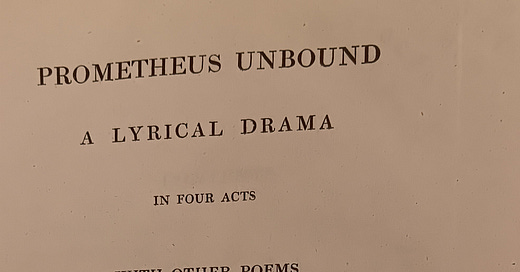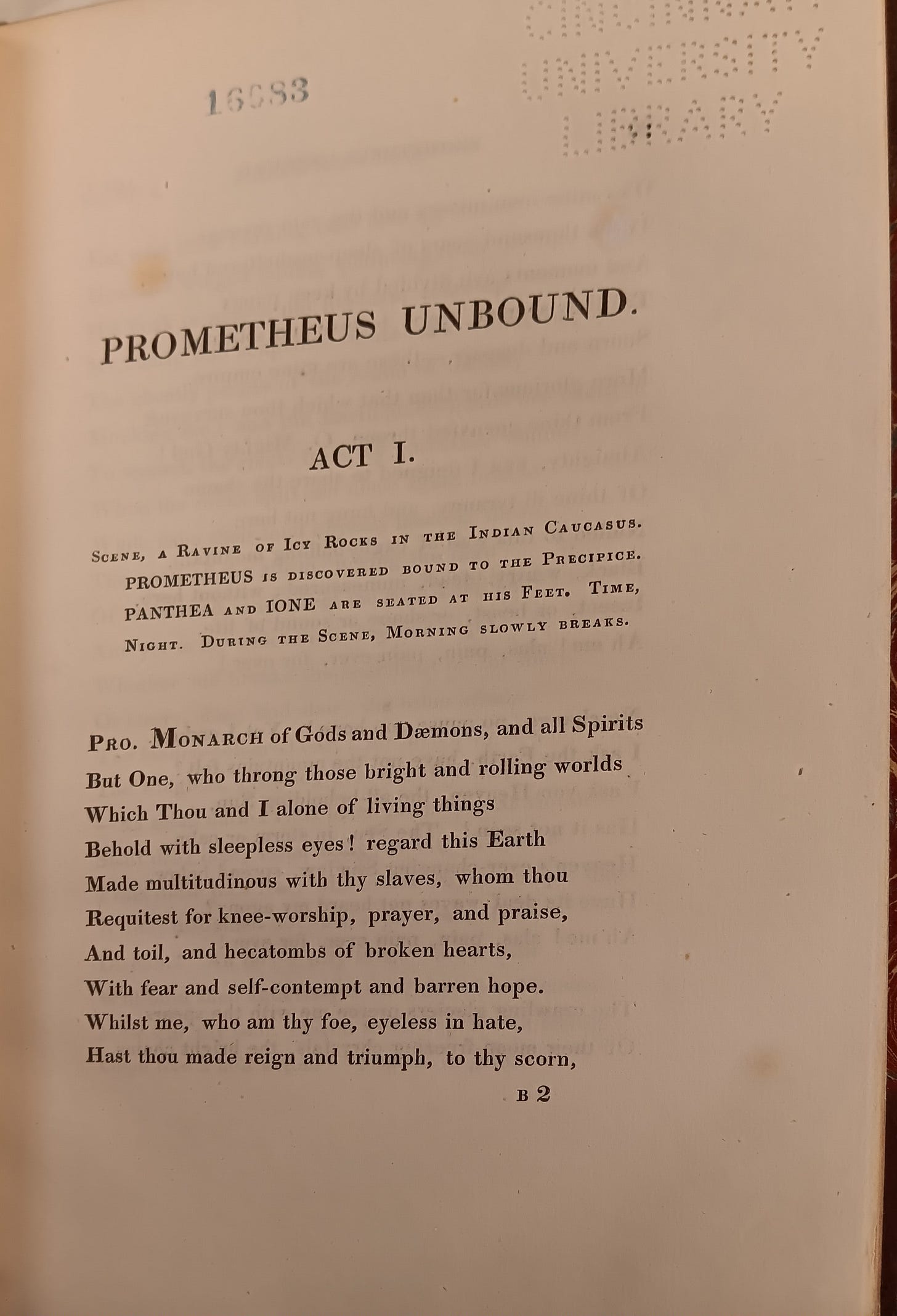Playing Book Detective: Prometheus Unbound by Percy Shelley
Beyond their text, a book holds many secrets. Examining its physical makeup can lead to profound discoveries like its history, creation and cultural context.
Preface and Updates
This school semester was a challenging one. While I learned a lot, my time was monopolized by the endeavor. That’s why for the first time in four years I took the holidays off. I anticipate (and hope) next semester won’t be so grueling, and I will resume my habit of publishing every other Thursday, even on holidays. But that remains to be seen.
Today I am posting two assignments form a rare books, special collections and archives class. I am particularly proud of the work I did. The assignments received a combined 19 out of a possible 20 points.
For these assignments I basically played book detective. By examine the book for clues and documenting those clues in a bibliographic file I was able to determine some interesting facts about it. For example, I believe the book here examined was carried across the Atlantic Ocean by the co-founder of Proctor and Gamble. I can’t prove that, but I make the case for its possibility by presenting the evidence I gathered.
In any case, this project was a lot of fun, and I hope you’ll enjoy reading about it.
Bibliography File
Prometheus Unbound, A Lyrical Drama in Four Acts with other Poems by Percy Bysshe Shelley. Published by C. and J. Ollier, Vere Street, Bond Street, London 1820. Printed by Marchant, Ingram-Court, Fenchurch-Street, London. Published for an unknown person.
Other major works by the author include The Cenci, The Revolt of Islam, Rosalind and Helen and Alastor, or the Spirit of Solitude.
This book was donated to the University of Cincinnati by W. A. Procter
Format
8vo, 120 leaves, approximately 240 pages. 8¾ by 5½ inches (Granniss, 1923). Lowercase roman numerals are used for the preface (vii-xiii). Arabic numerals are used for the main text (1-222). There are other pages with no pagination. Cancellation: misspelled “miscellaneous” on the contents page but is corrected in this copy (Granniss, 1923).
Advertisements
There is a page across from the title page advertising other works by Shelley. There are also two pages (or one leaf) in the back of the book which list “Works Lately Published by C. & J. Ollier.” Prices are included.
Typography
The font is a serif typeface with starkly contrasting thick and thin lines. It appears to be in the English modern style (Chappell, 1970 p. 180). The scene descriptions are in small capitals and have a second line indentation to set it apart from the spoken dialogue. The dialogue is indented for each new speaker. The name of each speaker is in all caps and terminates with a period; however, it is not well distinguished from the actual dialogue. Each line begins with a capital letter and some capitals are used within a line, presumably for emphasis. There is an extra space between a word and certain punctuation like semicolons, colons and question marks. The lines are well spaced and centered and justified left, leaving rather large margins. The typography is consistent with the styles used for literary publications in the early 19th century (19th Century Typography, n.d.).
Paper
The paper is heavy and has a slight grainy feel to it in some places while much smoother in others. The color is yellow-white and practically brown on the edges. There are blotches called “foxing,” according to Chris Harter, head librarian at the University of Cincinnati’s Archive and Rare Books department (personal communication, November 8, 2024). This is likely due to age rather than censorship. No watermarks or countermarks could be found. I believe it is made out of wove paper because, when looking at the pages with a backlight, I can’t find vertical chain lines but there is a kind of mesh pattern (Berger, 2014 p. 88). Typography and paper taken together suggests this book was influenced by John Baskerville’s work (Berger, 2014 p. 88).
Binding
According to Chris Harter (personal communication, November 8, 2024) the book has 3-quarters binding using leather for the quarters and spine. Marbled paper covers the rest (Berger, 2014 p. 93-95). The transitions are marked by a gold tooling line. The spine has raised bands with more tooling in decorative designs. The title and author are stamped in gold near the top. Overall, the condition is good. There are some signs of wear at the edges and corners, but the book seems to be in excellent shape given its age.
Historical Context
An analysis of the works of Percy Bysshe Shelley contained in this volume could - and I am sure have - filled entire books. Therefore, for brevity’s sake this essay, 1.) will focus on the titular entry Prometheus Unbound and 2.) should not be taken as exhaustive.
The years 1819 and 1820 were prolific for Shelley as he produced in this time many of the works that appear in this volume. Shelley himself regarded Prometheus Unbound as his best work (O’Connor, 2017 p. 3495). It combines mythology, contemporary drama and his own philosophical worldview.
As the title suggests, the drama was inspired by the Greek tragedy of Prometheus, a Titan who stole fire from the gods and gave it to Man. As punishment, Jupiter chains Prometheus to a boulder and sends an eagle to eat his liver every day. In some versions, Prometheus is freed by Hercules.
Shelley was specifically interested in Aeschylean’s version in which Jupiter and Prometheus reconcile at “the price of the disclosure of the danger threatened to his empire by the consummation of his marriage with Thetis” (O’Connor, 2017 p. 3496). Shelley’s Prometheus, however, achieves liberation through a moral victory, renouncing hatred and vengeance in favor of love and selflessness.
This theme is also reflected in Shelley’s contemporaneous work The Cenci. Although not appearing in this volume it is worth mentioning The Cenci as a foil to Prometheus Unbound. Whereas the latter is rooted in idealism the former concerns itself with gritty realism (O’Connor, 2017 p. 3496). The works serve as opposite images of Shelley’s philosophical truth: “that fortitude and forgiveness, rather than violent retaliation, are the proper responses to injustice” (p. 3492). In other words, one depicts the potential for moral transcendence while the other warns of the consequences of failing to achieve it.
For Shelley, Prometheus Unbound was an opportunity to ask profound moral and philosophical questions such as, “What is [nature’s] moral purpose?” (McLean, 2017 p. 2637). Because the atheist Shelley rejected conventional or orthodox beliefs like Christianity, he needed to create his own myths to explain - or at least try to explain - the moral mysteries of the universe. Coincidentally, this is the same argument put forward by Joshi (1990) concerning the writers of weird tales between 1880 and 1940. It seems Shelley, writing three generations earlier, also used the weird tale (i.e., mythology) to explore a worldview.
Prometheus Unbound was Shelley’s first “substantial” attempt at writing drama (O’Connor, 2017 p. 3496). It was also written in response to Shelley’s contemporaries, such as Johann Wolfgang von Goethe and Byron. Shelley would have been familiar with Goethe’s Faust and Byron’s Manfred (O’Connor, 2017 p. 3492). These two contemporary works are examples of poetic drama that Shelley likely read and sought to expand upon with his own play.
The bookplate at the front of the volume claims the book was donated to the University of Cincinnati by William A. Procter. Chris Harter, head librarian at the University of Cincinnati’s Archive and Rare Books department tells me this is the same William Procter who co-founded Procter and Gamble (personal communication, November 8, 2024). Also, according to Harter, Procter donated many books to the university, hence the bookplate attributing its presence to his generosity.
Who the book was printed for is uncertain. However, Procter was English-born and started business school there in 1888. By the late 1820s he had “connections” with the clothing industry in London (Wikipedia contributors, n.d.) where the book was printed. It is therefore possible, although as yet unproven, that this volume was printed for Procter while a student and/or businessman in London, who then carried it with him to America in 1830 and further still to Cincinnati in 1832 (Wikipedia contributors, n.d.).
The volume in UC’s possession is a first edition. Other editions could not be procured in time for analysis.
In conclusion, the volume discussed here has an interesting history as it relates to a Cincinnati celebrity of sorts. Procter’s legacy lives on in both his company’s continued existence and success as well as in his generous donation of books to UC. Shelley’s Prometheus Unbound is also a continuing legacy as it reveals the moral quandaries contemporary writers wrestled with, and how they wrestled with them through a dramatic medium.
References
19th Century Typography. (n.d.). 19thcentury.us. Retrieved November 10, 2024, from https://19thcentury.us/19th-century-typography/
Berger, S. (2014). Rare books and special collections. ALA Neal-Schuman.
Chappell, W. (1970). A short history of the printed word. Alfred A. Knopf: New York.
Granniss, R. S. (1923). A descriptive catalogue of the first additions in book form of the writing of Percy Bysshe Shelley. The Grolier Club: New York.
Joshi, S. T. (1990). The weird tale. Wildside Press.
McLean, J. L. (2017). Percy Bysshe Shelley. In Critical Survey of World Literature (pp. 2636–2644). Salem Press.
O’Connor, R. H. (2017). Percy Bysshe Shelley. In Critical Survey of Drama (3rd ed., pp. 3490–3499). Salem Press.
Wikipedia contributors. (n.d.). William Procter (industrialist). In Wikipedia. Retrieved November 17, 2024, from https://en.wikipedia.org/wiki/William_Procter_(industrialist)








I actually liked the physical description about the book the best part as I like to look at old books to see how they are constructed and year they were published. (I remember finding a 112-year-old book someone took with them to court to pass the time as they were waiting and they left it behind, I presume accidently, and without their name.) The information about "Prometheus Unbound" was also interesting as I could not recall some aspects of the myth.
Correction: Procter started in business in 1818.